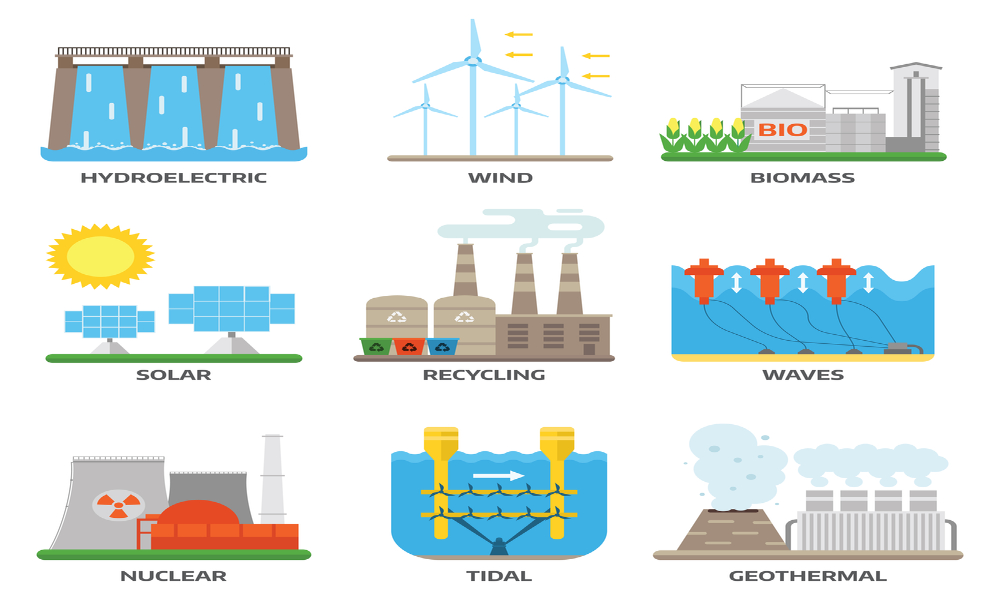The Importance of Green Energy Sources

Renewable energy is the best way to power our homes, cars, and economy while at the same time saving our precious planet and resources. There are many benefits of renewable energy, such as reduced fossil fuels consumption, reduced air pollution, and improved human health. As more people talk about reducing our carbon footprint to help mitigate climate change, let’s dive in and learn more about the benefits of renewable energy.
What is a Renewable Energy Source?

A renewable energy source is any heat or electricity generation technology that produces little or no CO2. These technologies are new and a little pricy, but the benefits of choosing renewable energy to power your home or business are countless. A renewable energy source relies on those sources of energy that nature in the United States can replenish on its own and involve no fossil fuels, such as coal, oil, or natural gas.
Types of Renewable Energy Sources
There are several renewable energy sources, depending on where the energy comes from. Not all energy sources are created equal, so make sure you understand their pros and cons before purchasing a renewable energy plan. There are five basic types of renewable energy sources:
- Wind power,
- Solar power,
- Geothermal energy,
- Hydroelectric energy, and
- Biomass energy.
Wind Power
Wind Power is the energy that is harnessed from the wind. As the wind blows, it spins the arms of wind turbines, which spin the turbines for electricity generation. This is the most widespread form of renewable energy in the USA. Windmills in Texas wind farms alone can produce more than 30,000 MW of green energy, more than any other U.S. state.
Solar Power
Solar Power is the second most utilized of all the renewable energy sources in the USA. Solar power can be used using solar PV panels, solar towers, or even solar collectors. Solar panels and towers generate electricity, while solar collectors heat water and your home during the coldest of months. Solar panels in California make this state number one in the United States by solar power generation.
Geothermal Energy
Geothermal energy is another source of renewable energy that has much potential. This technology produces both electricity and hot water and is already used worldwide to heat both residential and public buildings. As the government sees the benefits of using geothermal energy sources instead of power plants, you can expect greenhouse gas emissions to fall and more of your electricity to have zero impact on climate.
Hydroelectric Energy
Hydroelectric energy is a form of renewable energy that was used first. When you produce hydropower, you rely on rivers and lakes and their water to produce electricity. With no air pollutants released and no carbon dioxide created during the power generation process, this is one of the cheapest renewable energy technologies used in the United States.
Biomass Energy
Biomass energy is the perfect way to heat and power your home and farmstead, especially if you have a lot of organic waste or animals you take care of. There are two basic ways to use biomass energy for heat and power generation:
- Biomass burning (energy recovery) – produces very little ash, and the CO 2 released is the same CO2 that the plants captured during the growing season,
- Biomass digestion – where we rely on microorganisms, such as bacteria and viruses, to naturally decompose the biomass and turn it into compost or humus that can enrich your soils. There are two types of biomass digestion:
- Aerobic Biomass Digestion – relies on aerobic bacteria and oxygen from the air to decompose organic materials – the final product is compost,
- Anaerobic Biomass Digestion – relies on anaerobic bacteria and water to decompose the organic material – the final product is humus.
On a larger scale, this technology takes care of your municipal green waste, turning it into rich, fertile compost or humus for the wast fields in the USA. At the same time, these renewable energy technologies can be used to heat and power millions of United States households, effectively reducing our carbon footprint in the process and improving human health.
Advantages of Renewable Energy

There are many benefits of renewable energy. Besides the most commonly seen advantages of renewable energy that say that it helps fight climate change, governments also love it because it stimulates economic growth, there is less maintenance, and renewable energy prices are lower than fossil fuels energy prices. Wind and solar energy, for example, are cheaper to build and maintain than coal-powered plants. Here are all benefits of renewable energy:
1. Environmental Impacts
As is crystal clear, solar energy and other renewable options can have a huge environmental impact in terms of CO2 released and climate change mitigation. As world governments have agreed by signing the Paris Treaty, extreme weather events are a direct consequence of human-induced climate change. Learn how wind farms and solar solutions can help mitigate these events.
Help Mitigate Global Warming
Renewable Energy reduces out greenhouse gas emissions, especially carbon dioxide. This means that renewable energy helps fight climate change and extreme weather events while producing cleaner electricity than power plants. Solar energy is the leader in the field, as it uses existing roofing and gives it another function.
Lower Water Scarcity Levels
In the United States alone, almost 40% of freshwater consumed goes to cool power plants and prevents them from overheating. This is not the case with renewable energy, as no water is used to cool either solar panels or windmills. This helps save precious resources and reduce water shortage events.
Significantly Reduce Pollution
Although there is some air pollution associated with producing solar panels and other renewable energy technologies, this amount of CO2 is easily set off during the lifetime of your renewable energy products. You will be able to save as much as 2lbs of CO2 from entering the atmosphere when relying on solar energy to power your home.
2. Improved Public Health
Fossil fuels are associated with greenhouse gas emissions. The gases normally released in a power plant include carbon monoxide, carbon dioxide, sulfur monoxide, and sulfur dioxide, among many other gases that can harm your health and result in high medical bills. By relying on renewable energy, you make sure that no air pollution enters your lung and invest in your health.
Renewables have the following health effects:
- reduced number of heart attacks,
- reduced cases of pneumonia,
- reduced blood pressure,
- reduced instances of stroke and stroke-related deaths, and
- other beneficial effects on health.
3. Economic Growth
New technologies mean a lot of research and a lot of new jobs. While it does hold true that the sector receives huge tax advantages, the benefits of going for renewable technologies are multiple. The USA alone has created tens of thousands of new jobs and has created new ways to save and make money. The economic benefits show promising results as they usher in a new energy chapter.
Increased Employment
Investing in solar energy and other renewable resources is a sure way to bring new jobs into the U.S. Many U.S. states can boast that they have thousands of solar and wind jobs. Governments have long ago realized the benefits of investing in renewable energy resources, as they give back to the community. Furthermore, good health impacts your ability to work and enables you to work longer and stay healthier for a longer time.
Income for Land Property Owners
Relying on renewables can also give you additional income. Placing solar panels on your rooftop means no more electric bills, and the savings connected to this practice can add up to tens of thousands of dollars over a 20-year period. Many businesses also choose to rely on renewables to power their buildings and machines and save money.
Furthermore, if you are one of the large landowners and would like to make extra income, erecting a wind turbine or renting the land to someone who would like to do so can bring in extra cash. You can also sell SRECs or RECs and energy to utility companies and energy providers.
Property Value Appreciation
Installing a solar energy system on your rooftop can significantly increase the property value. As it seems, air quality and no environmental damage are greatly appreciated in the states. To make the switch to renewables even easier, many states have introduced Property Value Appreciation Tax Exemption.
Energy Cost Savings
Energy prices and fuel costs have soared in the past two decades. Going green and opting for renewable resources can help you avoid some of these costs and price fluctuations. As renewable resources are so abundant, the problem with the availability of fossil fuels and high energy prices is not a problem anymore. Solar energy is now the cheapest energy source in history.
Energy Independence
A Tesla EV car in your garage and a Tesla Powerwall is all you need for an energy-independent future and significant savings. Installing solar panels and going green in the U.S. is the best way to ensure energy independence and gain better control over your money. Entire communities invest in solar and hydroelectricity to help the environment and reduce the impacts of climate change.
4. Supply Replenishes Naturally
Unlike coal and natural gas, green resources replenish naturally. Biomass takes less than a year to regrow, and solar, wind, and hydro are replenished daily. There are no issues with the availability of green resources, so the prices are kept low.
5. Less Maintenance
Green power comes with less maintenance and brings in huge economic benefits. Less maintenance means fewer workers and lower energy prices. Every large renewable project development also incorporates this massive benefit in their calculations.
6. Cost Efficiency
Cost efficiency is one of the long-term benefits of switching to green power. Low maintenance and operating costs reduce the price of electricity in most cases. Although the capital investment may be higher, depending on the type of power source and the region you live in, long-term speaking, you will be able to save massive amounts of money.
7. Consumer Price Stability
Low electricity prices and high cost-efficiency also mean that the electricity service is delivered to the customers at stable prices. High reliability, especially with biomass and geothermal energy, means that a power failure, as we could see in Texas in the winter of 2020/2021, is very unlikely to happen. This translated into stable prices and reliable service.
8. Resistance to Large-Scale Failures
Fossil fuel power generation is centralized, and it relies on a vast infrastructure network to provide your area with power. This means that there are a lot of chances of failures and blackouts. On the other hand, relying on green power means that power generation is decentralized, supported by thousands of small producers and that the total storage capacity is very high. There is no storage and no economic benefits in an energy crisis with fossil fuel power plants.
Disadvantages of Renewable Energy
Of course, there are some disadvantages to going green including green energy scams. In many regions, geothermal energy is unavailable, and sunshine can be observed for only a part of the year. With large-scale projects, the environment may suffer, as solar and windmill farms take up a lot of space and demand land clearing. Read on to learn more about the disadvantages of renewable energy.
Steep Preliminary Costs
There are high investment costs connected to building any renewable energy system. The biggest issue is land, which is in high demand. However, building these projects means that we can slowly phase out other power plants and reduce dependence on fossil fuels. Low operation costs are another advantage of renewable energy that pays off in the long run.
Sporadic Supply
Sporadic supply is a big disadvantage of renewable resources. As is known, the sun does not always shine, and the wind does not always blow. To mitigate these issues, we need smart power grids, a combination of renewable technologies, and the ability to store power. This brings us to the next disadvantage of renewable energy.
Elevated Need for Storage
Since renewable resources are sporadic and not as energy-dense as their fossil counterparts, storing energy is of paramount importance. Solar batteries, switching power consumption, and smart appliances are all the ways we can increase our resilience and rely on green energy resources more. Luckily, energy storage solutions are getting cheaper and are subsidized by the U.S. government.
Geographical Constraints
Not all areas of the globe have the same conditions for green energy resources. The northern part of the United States, for example, receives very little sunlight. On the other hand, these parts are rich in geothermal. Wind power makes no sense in hilly areas, as the hills block the wind. Likewise, biomass only makes sense in areas with high agricultural activity since it comes from the fields themselves
FAQs
What is the best form of renewable energy?
There are many different renewable technologies that you can consider. The best form of renewable energy for residential use is solar power combined with either net-metering policies or home solar battery storage. Depending on your needs, you may opt for different green technology.
What are the benefits of ocean energy?
Ocean energy comes in two forms: wave energy and tidal energy. They are both very predictable and can be used in cliffy or old industrial areas otherwise unlike to be used. The tidal energy alone, if fully utilized, could power the USA.
What is the dirtiest energy source?
Coal is the dirtiest energy source. Coal releases almost 2lbs of CO2 for every kWh of energy produced, unlike natural gas, which produces 1lbs per kWh of energy. This is by far the dirtiest energy source we have today. Renewable sources, on the other hand, produce no net carbon.
Final Words
Solar energy and other forms of renewable power are the answer to the air pollution issues in the United States. As governments move towards greener ways to power our economy, we can see that renewable energy technologies get cheaper, solar energy is used more, greenhouse gas emissions are reduced, and our carbon footprint is significantly reduced. Besides these, there are many benefits of renewable resources, which you too can enjoy, especially if you choose a green energy plan or decide to install solar panels on your home.
Updated on
